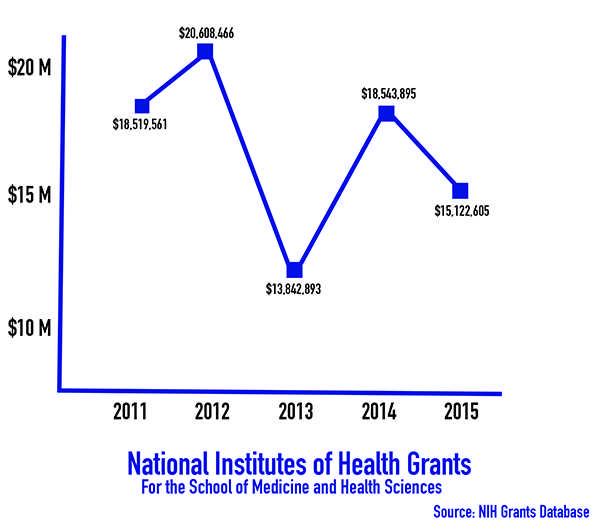More researchers are turning to outside grants as the amount of federal grant money available for faculty at the School of Medicine and Health Sciences is on the decline.
Funding from the National Institutes of Health to SMHS has dropped by $3 million this year while grants from outside sources have increased, a spokeswoman for the school said. Researchers who received grants this year from the NIH said that federal funding is restrained and more researchers are looking outside of federal funding for a better chance of being awarded grants.
Researchers in SMHS received 27 percent less funding from the NIH this year than it did in 2012. In fiscal year 2015, SMHS received about $15 million in grants, but in fiscal year 2012 that number reached $20 million.
The amount received in NIH grants dropped in fiscal year 2013 to nearly $14 million, before increasing the next year to more than $18 million.
University Spokeswoman Anne Banner said in an email that there has been only slight fluctuation over the past three years in the amount of researchers applying to federal grants, and that it is not a downward trend.
“Since 2014, SMHS has been recruiting, so our number of SMHS researchers applying for grants is going up,” Banner said.
Banner said that while there has been “a slight decrease in project proposals,” the number of new awards has doubled from 2013 to 2015. Researchers are working to diversify funding sources now that there are fewer opportunities through the NIH, Banner said.
In the 2014 fiscal year, 22 principal investigators were funded from sources outside of the NIH or the National Science Fund, and that number has increased to 27 principal investigators funded from sources outside those federal agencies this year, Banner said.
Paul Brindley, a professor of microbiology, immunology and tropical medicine, currently holds three active grants from the NIH. Brindley said that he and other researchers are facing pressure from officials in the school to apply for more grants in general, in hopes of earning more money as it gets more competitive to earn federal funding.
“In the schools in particular ‒ say, the school of medicine and the various deans or department chairs ‒ they are oftentimes shaking us down to put more in,” Brindley said. “We are all facing the thought that one in 10 is going to make it. For me it is a lot like playing the lottery, and if you don’t play, you don’t win.”
Brindley said that he believes researchers are increasingly looking for funding outside of federal agencies, but he believed the Office for the Vice President of Research could do a better job of helping researchers identify more grants to apply to, he added.
“The NIH is this arcane, massive place and there are all these funky little obscure things that they are advertising,” Brindley said. “I have always felt that OVPR could really get to know what people want to do in a general way and then kind of have someone scanning over these federal documents that advertise this stuff.”
As research funding has become more difficult to secure, SMHS officials plan to put more than 20 percent of their $225 million fundraising goal toward research.
Michael Bukrinsky, a professor of microbiology, immunology and tropical medicine who currently has two active grants from the NIH, said he is not optimistic about the increased difficulty to earn grants because the NIH budget is restrained, and not because researchers aren’t trying to earn those dollars.
“The fact is that many people get discouraged and stop applying,” Bukrinsky said. “It is a very difficult situation and I am very concerned especially for young investigators, but even established investigators, we will lose these people and that would be a great loss to science in general and to GW in particular.”







